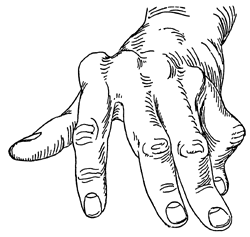What is it?
Rheumatoid arthritis is an illness that can affect almost every organ in the body. It often attacks the tissues, called synovium, that line the joints and tendons. The tissue becomes swollen and covers the joints, destroying bone and cartilage. The exact cause of rheumatoid arthritis is not known. It affects about 1% of the population, women more often than men.
What are the signs and symptoms?
In the early stages of the disease, joint problems are the most common symptoms. A general sense of being tired, or just not feeling quite right, often happens before the slow start of joint pain and swelling. Morning stiffness is a frequent complaint. As the disease continues, symptoms may include swelling of different joints in the hands, wrists, elbows, shoulders, hips, knees, and feet. The swelling usually takes place in the same joint on both sides of the body, known as symmetrical swelling. Rheumatoid arthritis may result in pain and deformity. Occasionally, the disease affects other organs of the body, such as the heart, eyes, and lungs.
How does it affect the hand?
Generally, the first and most common complaint is swelling of the hand at the knuckles, that gives the fingers a spindle shape. This swelling often happens in the wrist and the large knuckles in the middle of the hand. The swollen tissue may destroy the ligaments that hold the joints together, and damage cartilage and bone. This can result in certain deformities. The wrist may turn toward the thumb side of the hand, causing “ulnar drift” of the fingers (see Figure 1). The swollen tissue may also produce damage, causing the tendons to rupture. When the tendon ruptures, you may not be able to bend or straighten your finger. Other problems that may happen are swelling that causes pressure on the nerves (carpal tunnel syndrome), or lumps (rheumatoid nodules) found over various joints of the hand and elbow.
How is it treated?
Rheumatoid arthritis is usually treated with medication. Surgery may help when medicine does not control the disease. A wide variety of non-steroidal, anti-inflammatory, cortisone-like prescriptions are usually used. Education for learning to live with the limitations caused by this disease, such as aids for daily activities, splinting, and information on how to avoid damaging the swollen joints, can be provided by a hand therapist. Contact your local Arthritis Foundation for resources and more information about rheumatoid arthritis.
Surgery may only be considered when medical treatment does not work. The goals of surgery are to: 1) reduce pain, 2) improve function, and 3) improve appearance. Surgical treatment may include removing the swollen tissue from the joints or around the tendons, which may reduce pain and prevent more tendon damage. If the tendon has already been damaged, surgery may be done to repair the damage. Rheumatoid nodules may be surgically removed to improve appearance and comfort. In some cases, large knuckles of the hand may be treated by arthroplasty, a procedure where artificial knuckles (made of silicone rubber or other material) are inserted. This may improve the use of the hand and lessen pain. Surgical procedures performed on the rheumatoid hand and wrist are often complex and may require therapy.
Figure 1
Typical appearance of the hand in rheumatoid arthritis. (Ulnar drift, swelling and dislocations, little finger deformity.)
Copyright © American Society for Surgery of the Hand.
All content copied with permission from ASSH (www.assh.org).

